








Ajanta Caves



pilgrimage
centers
Amarnath
Amritsar
Ayodhya
Badrinath
Bodha
Gaya
jyothirlingas
kanyakumari
Khajuraho
konark temple
Madurai
Mathura
Pandharpur
Pashupatinath
Puri Jagannath
Rameswaram
Rishikesh
Sarnath
Satya sai baba
Shani Shingnapur
Srikalahasti
Shri
Lakshmi GoldenTemple
Tirupathi
Vaishno Devi
SadGurus
Akkalkot
Maharaj
Shripad
SriVallabh
Dwadasa
jyotirlingas
Somanath
Shrishailam
Omkareshwar
Vaidyanath
Maha
Kaleshwar
Kashi
vishwanath
Bhimashankar
kedarnath
Nageshwer
Trimbakeshwar
Grishneshwar
Shakti
peethas
Sightseeing
Agra
Ajanta caves
Delhi
Ellora caves
Goa
Jaipur
Kashmir
Manasarovar
Foreign Trips

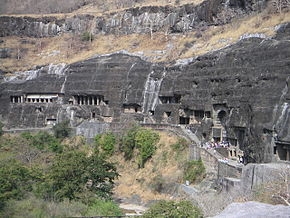

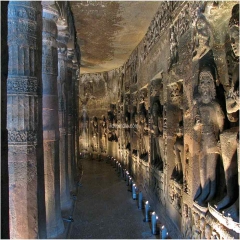
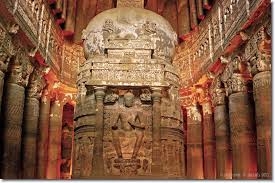
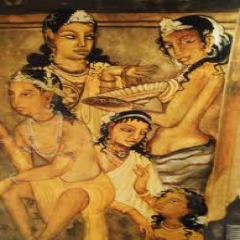
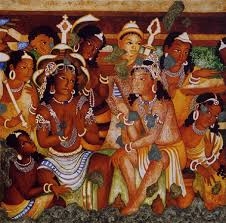

Cave 2 is
also clearly inspired from Cave 1. Its doorways are influenced from
the many ancient temples found in India. The ceiling is intricately
designed and decorated exuberantly. The walls inside have an image
of a Thousand Buddhas, painted with astonishing detailing. The
corridor towards the right shows a puerile girl on a swing – called
the Woman on Swing – which highlights Buddha’s thoughts that
physical energy led to illumination.
Cave 4 was made simultaneously with Cave 17, but was left
unfinished. There lie a huge number of incomplete paintings from
Buddha’s life. A crouching deer, dwarf musuician, and floral
plaster are some of the many things found in this cave.
Cave 6 is representative of the Mahayana period. There lies an
image of a seated Buddha, surrounded by flying pairs of couples.
The pillars in these caves are much more fine than the earlier
caves and are in an octagonal shape. It has the painting of the
Bhikshu with Lotus.
Cave 9 accomodates the Chaitya Hall of Gathering. It has a Giant
Horseshoe Window. The Naga Worshippers and the Frieze of Animals
and Herdsmen are two paintings that can still be seen there.
Cave 10 more or less resembles Cave 9 in its style and
architecture. You have the Shada-Dant Jataka – Buddha incarnated as
an elephant. There can also be seen the depiction of a King with
his Retinue and the Shyama Jataka. The Princess and Tusk and the
Buddha with the One-Eyed Monk are other two paintings that must be
checked out. Cave 11 is mainly concerned with indicating the shift
fro the Hinayana period to the Mahayana Period. It bares Buddhist
Stupas.
Cave 16 has a beautifully made porched doorway that lay the
foundation to the other doorways. This particular cave gives a
breathtaking view of the river beneath. This cave has the Giant
Buddha Statue, a depiction of Buddha with a Begging Bowl, the
Descent of Lord Buddha and Prince Siddhartha (Buddha) stretching a
bow. This cave is also home to the world famous art – Dying
Princess – that displays the princess’ shock when she gets to know
about her husband becoming a monk. The Sutasama Jataka is also
another sculpture that is a must watch.
Cave 17 shows paintings that symbolize love, like the Apsaras and
Flying Spirits and the Indra and the Apsaras. Apsaras mean Angels.
The Buddha Returns shows how Princess Siddhartha returned as a
beggar to reconcile with his wife and
children.
Cave 21
is more sensibly devised than the other caves. The area has been
used judiciously with well carved pillars. Paintings that were hung
on the walls once upon a time are now replaced by plasters. It
contains of the Chaitya Hall – an open court that lies close to the
verandah. A structure composed of a series of arches and supported
by 26 pillars is found in here. This wall also has relief
sculptures. The verandah has a wall close to it that has the
Buddha’s statue on it, albeit in a dead state. Believed to be his
sculpture in a sleeping form, the Buddhists claim that Buddha is in
his Parinirvana here. The same wall that accommodates the Buddha in
his Parinirvana state also houses a sculpture called the Temptation
of Buddha.
Cave 24 consists of 3 components – The Pillar Style, the Pilaster
and the Porched Doorway. The pillar styles found in this cave are
incomplete, but are noteworthy of its origination. Starting with
rough and uneven pillars, it evolved to octagonal pillars with
proper finishing, in the Mahayana Period. The porch end consists of
an elaborately created pilaster. Cave 24 was however left
incomplete. A later addition in and around the 7th Century, the
Porched Doorway is in the upper right corner and is in the shape of
a T.
Cave 26 comprises the Sravasti Miracle, Family Group, and Buddha
Head with Curly Hair. The passage that circumvents the cave is full
of carvings depicting the miracles that Buddha performed in his
time. Sravasti is a village that is believed to have been lucky to
have witnessed the great Buddha present himself in the skies above,
in all his forms. The Family Group is the depiction of an ideal
family during that time. It has flowery decoration. Buddha Head
With Curly Hair is simply a depiction of the head of Buddha,
complete with curly hair and huge ears. Legend has it that Buddha
was seated on a lotus that was believed to be the centre of the
cosmic universe. The Nagas, Nanda and Anumpananda are the ones that
hold the lotus stem. The Chaitya Horseshoe Arch exhibits fantastic
images sculpted deftly, and date back to the 5th Century.
Cave 27 has two parts to it – the Naga Dwarpala and the Porched
Doorway. The outer wing of the Buddhist shrine lies the Naga
Dwarpala. This cave is greatly inspired by the Cave numbered 20.
Hence, though the Naga here resembles the Naga found in Cave 20, it
doesn’t look as charming as its counterpart. The Porched Sorrway,
meanwhile, is inspired from Cave Number 2.
A Perfect Visit Any Time Of The Year - Ajanta Climate
The Ajanta Caves are unaffected by the prevailing weather
conditions. This site can be visited at all times of the year.
However, the summer season is advised to be skipped out on, as
there is quite a bit of walking to do – an activity that might tire
you in the scorching summer heat. The monsoons are hands down the
best time to visit this fantastic place, as the river right below
the Caves are in full bloom, and the gushing water, combined with
the abundant greenery makes for a perfect memorable
experience.
How to reach Ajanta
The Ajanta Caves are easily accessible by air, road and rail. The
Aurangabad Airport, at a distance of 100 km, is the closest
airport, if one decides to Travel by air. There are also several
trains that ply from various cities in India to Aurangabad and
Jalgaon – two cities extremely close to the Ajanta Caves. If
travelling by road, one can opt from the many Bus Tour services
offered by the State Government Transport or the private bus tours.
From Aurangabad, Ajanta Caves is around two to three hours
away.
These caves are better seen in person than merely read about. The
enormity and grandness of this heritage sites are one of those few
destinations in the world you must visit before you die. Don’t miss
on this wonder for anything. The mystical charm of these caves will
have you zapped.
Advertisement
I am a text block. Click on me to drag me around or click a corner handle to resize me. Click the settings icon (it's the left one, looks like a cog) to change this text. You can type new text into me or cut and paste text from somewhere else. Click outside of me when you're done and any changes will be saved.





Site designed and Maintained by Harish





